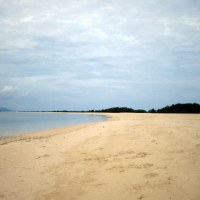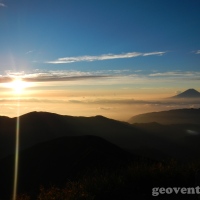The town of Beppu in Oita Prefecture, Japan is blessed with piping hot geothermal waters. Beppu is frequented by tourists not only for its hot springs (onsen) but also for its “hells” (jigoku). Hot spring resorts/public baths abound all over Japan, but the jigoku is unique to Beppu. All eight hells could be toured in half a day, but we stayed overnight so we could also try Beppu’s famous onsens.
Getting there
Beppu can be accessed by train or bus from Fukuoka, which is the nearest major airport. You can also get a train from Tokyo or Kyoto, but chances are you would also have to stop by Hakata station in Fukuoka.
In our case, we chose to travel using the Nishitetsu Bus, since it’s the cheapest way to get to Beppu from Fukuoka. We used the Toyonokuni Kippu, which is a discounted set of four tickets for a certain route. A one-way bus ticket normally costs 3,100 JPY but with the toyonokuni, one ticket is only 2,000 JPY each (provided you have a companion). The travel time takes 2 hrs 40 mins, as opposed to the bullet train’s 1 hr 40 mins (but costs 5,600 JPY). We bought tickets at the Hakata Bus Terminal a few minutes before departure (no reservations for this route) and got off at the Beppu Kitahama bus stop. We then walked for about 10 minutes to the Beppu train station.
Touring the hells
At the train station, we proceeded to the Tourist Information Center where we got the following: One-day bus pass (900 JPY), Jigoku tour information sheet, bus timetable, and discount coupon for the hells and other Beppu tourist attractions. The nice lady at the counter explained everything that we needed to know about visiting the hells.
Armed with our sheets of paper, we waited for the next scheduled bus departure for the Kannawa area, where the first six hells are located. Buses depart every 15-30 minutes. We decided to buy the ticket booklet for all eight hells, since it felt like a bargain. We only paid 1,800 JPY for the booklet (original price was 2,000 JPY but we got the discount coupon from the information office) as opposed to 400 JPY entrance fee for each hell. We came for a tour of the hells, so we might as well just visit all of them, right? Here I’ll briefly describe all eight hells and give my verdict at the end whether all eight were visit-worthy.
Umi Jigoku (Sea Hell)
We were greeted by nice lotus flowers on the entrance, then we had to pass by the big souvenir shop to get to the pond. This hell was named as the Sea Hell because of the blue color of the water (which is of course not its natural color). There was a small shrine at one side of the pond, and a manicured garden on the opposite end.
The large compound also includes a greenhouse that gets it heat from the hot spring. I felt a little disoriented at first, seeing banana trees and wild orchids in Japan, or maybe it was just the unbearable heat of the summer plus the heat inside the greenhouse that got to me, but after a while I got to appreciate the novelty of growing tropical plants by utilizing the hot spring.
Just outside the Umi Jigoku entrance, there were several stores selling pudding that was cooked from the hot spring steam. Of course we tried this specialty product, but we were a little disappointed by the bitter aftertaste of the caramelized sugar. Maybe we just chose the wrong store and got unlucky.
Oniishibozu Jigoku (Monk’s Shaved Head Hell)
The bubbling mud pools were interesting, and a bit hypnotizing if you stare too long at the perfectly round bubbles coming up the surface. I was trying to imagine monks being borne headfirst from the bubbles as the name suggests, but my scientific mind could only conjure the image of the upper half of Saturn complete with rings. There were several pools showcasing these bubbles, but the real reward was the foot bath near the entrance.
Yama Jigoku (Mountain Hell)
It’s so named because there was supposedly a mountain of mud here, but all I can see were a smoking pile of rocks. There were some animals that supposedly added to the attraction, but they didn’t look too happy to be there.

The hippo’s mouth appears to be permanently open, just waiting for the tourists to throw carrots into it.
Kamado Jigoku (Cooking Pot Hell)
This hell features a pond that looks like the Sea Hell (although not quite as well-designed), a foot bath (which we skipped because the water looked murky plus it was packed with tourists), and a demon figure that is standing in a cooking pot (hence the name). One interesting point for me was that they tried to explain the geologic origin of silica sinter (yeah yeah, I know this is not interesting for most of you).
Oniyama Jigoku (Demon Mountain Hell)
One word: crocodile. There were a lot of Malaysian crocodiles enjoying the warm waters of this hell (according to the information on the billboard). Aside from the crocs, the pond in this place is spurting water due to the strong steam.
Shiraike Jigoku (White Pond Hell)
This hell is named after the creamy white color of the water, but we were first directed to some aquariums with piranhas and other exotic fishes. I can’t say I enjoyed looking at the fishes in the water tanks, but at least I can say I’ve seen a lot of piranhas at one time. The pond itself is milky green in color, with white hot steam coming out.
Chinoike Jigoku (Blood Pond Hell)
To get to this place we had to take the bus (about 10 minutes), since it’s in a different area than the first six hells. Before we got to the pond, we had to pass by the big souvenir shop that serves as the entrance. To me, the pond’s color is not really blood-red but orange-brown. The color comes from the clayey mud, which is being sold there as treatment for the skin.
Tatsumaki Jigoku (Spout Hell)
This last attraction is just beside the Blood Pond Hell. It’s a geyser that erupts every 40 minutes (which they are very proud of, since it’s one of the few geysers in the world that erupt hourly). One of the staff will tell you upon entering what time the next eruption will be, so that you can decide to visit the Blood Pond Hell first if the geyser just erupted. I haven’t seen a geyser erupt before so it was a new experience for me. Sadly (at least for me), they put up a stone ceiling above the geyser to prevent it from reaching its full height so that they can build the souvenir shop just beside it and so that people can go as near as they can to the Spout Hell.
So there you have them, all eight hells of Beppu. If you want to ask me if all eight hells were visit-worthy, I would say I would only pick the Sea Hell, the Monk’s Shaved Head Hell, and the Spout Hell if I was pressed for time and budget. Also, because we visited during the height of summer, we didn’t really appreciate the warmth of the foot baths and hot springs because of the terrible heat and humidity. But I must say I did not regret visiting all of them, since I had had the complete “hell” experience, both the good and not so nice.
It was actually fun completing the stamp rally (putting a stamp on each of the hells) which supposedly will give us some souvenir as reward if we submit the completed sheet of paper with our address, although I have yet to receive the prize. If you also want to visit all of them, there’s no stopping you from completing all those stamps!
Sidetrip: Taking a bath at the onsen
Aside from the hells, Beppu is not Beppu if not for the onsen (hot spring baths). Even though it was the peak of summer, we couldn’t resist taking a dip in the popular baths of Beppu. We tried two of the most popular onsen, which could not have been more different from each other: the large and modern Aqua Garden and Tanayu Bath at the Suginoi Hotel, and the small and traditional Takegawara Onsen.
Suginoi Hotel
This hotel is one of the biggest in Beppu, and the Aqua Garden and Tanayu hot spring bath is open to non-guests for an entrance fee of 1,500 yen. The entrance fee included toiletries, including large fluffy towels. They also have a free shuttle service from the Beppu train station, so going all the way up to this hotel on the hill was not a problem. The Aqua Garden is not gender-restricted and requires swimming attire that I did not bring, so I had to rent a swim suit for 400 yen. The water in the pool was warm and comfortable. There was a lights and sound show that makes use of a projector, a water fountain and a smoke machine, which made for a unique show. After watching the show, we had an enjoyable dip at the gender-separated Tanayu open air hot bath. It was relaxing to dip in the hot infinity pools whilst enjoying the view of the city (obviously, photos are not allowed inside the bath ).
Takegawara Onsen
This bathing facility is said to be the oldest in Beppu. It only cost 100 yen to enter. The bathing area itself is really basic in stark contrast to that of Suginoi Hotel, with just one pool that I couldn’t dip in because it was extremely hot (a few centigrades hotter then the regular onsen). There were some wash basins and stools but not much else, so the visitor should bring his/her own toiletries. I didn’t stay long because the water was too hot, but the old regulars seem to enjoy the bath. I had a little headache after that, but I was still glad that I got to experience the ‘authentic’ Japanese public bath.
I’m sure I would love Beppu even more if I visited during any other season except summer. I can enjoy and appreciate the hells and the hot spring baths properly when I’m not sweating like crazy from the humidity. I’d definitely go back to Beppu in winter!



























